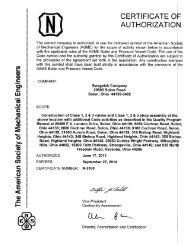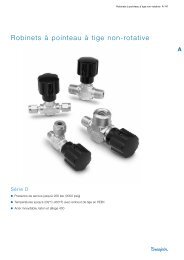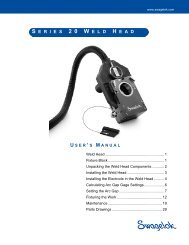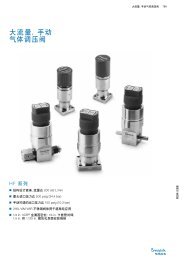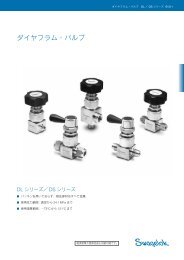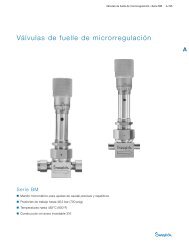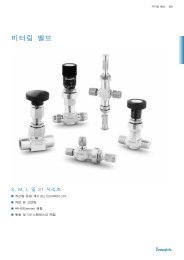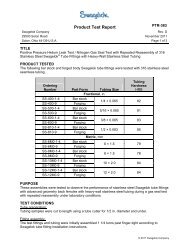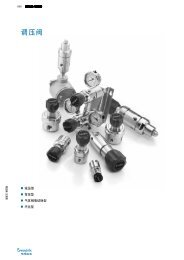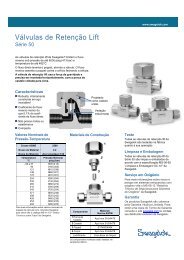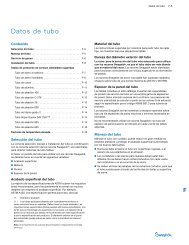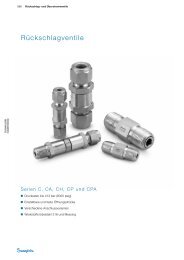HPRSS4,8 - Swagelok
HPRSS4,8 - Swagelok
HPRSS4,8 - Swagelok
You also want an ePaper? Increase the reach of your titles
YUMPU automatically turns print PDFs into web optimized ePapers that Google loves.
<strong>HPRSS4</strong>,8<br />
USER MANUAL<br />
Read the complete manual before installing and using the regulator.<br />
<strong>HPRSS4</strong>,8 User Manual<br />
Rev.date: 20-09-2010
WARNING<br />
INCORRECT OR IMPROPER USE OF THIS PRODUCT CAN CAUSE SERIOUS PERSONAL<br />
INJURY AND PROPERTY DAMAGE.<br />
Due to the variety of operating conditions and applications for this product, the user is solely<br />
responsible for making the final proper decisions concerning the correct assembly and functioning of<br />
the product and assuring that all the performance, safety and warning requirements are met.<br />
• Users must be trained and equipped for the handling, use and servicing of pressure products<br />
and systems.<br />
• Users must contact their gas or liquid supplier for specific safety precautions and instructions.<br />
• Gaseous media should be free of excessive moisture to prevent icing at high flow.<br />
• Always wear the appropriate protective clothing, including safety glasses, gloves etc. if required.<br />
• Follow the applicable safety and maintenance procedures.<br />
• Obey specific local regulations.<br />
• Do not exceed the maximum inlet and outlet pressure of the product or its accessories.<br />
• Operate within the temperature limits and other conditions specified for the product.<br />
• Do not drop or damage the product in any other way. This may negatively effect the<br />
performance of the product which can cause the product to malfunction.<br />
• Venting fluids and gases can be dangerous. Vent to a safe environment away from people.<br />
Ensure adequate ventilation.<br />
• This product is not oxygen clean and therefore not suitable for oxygen service.<br />
If there are questions or problems regarding the installation, operation and maintenance these should<br />
be directed to the proper authority on site before continuing.<br />
<strong>HPRSS4</strong>,8 User Manual<br />
Rev.date: 20-09-2010
CONTENTS<br />
1 Introduction ..................................................................................................................................... 1<br />
1.1 Detailed description ....................................................................................................................... 1<br />
1.2 Special features and options ......................................................................................................... 1<br />
1.3 Typical picture of the standard <strong>HPRSS4</strong> and its components ...................................................... 2<br />
1.4 Typical picture of the standard HPRSS8 and its components ...................................................... 3<br />
2 Installation ....................................................................................................................................... 4<br />
2.1 Points of attention before installation ............................................................................................ 4<br />
2.2 Oxygen service ............................................................................................................................. 4<br />
2.3 Installation instructions .................................................................................................................. 4<br />
3 Operation ......................................................................................................................................... 5<br />
3.1 Required tools for operation .......................................................................................................... 5<br />
3.2 Points of attention before operation .............................................................................................. 5<br />
3.3 Changing the set pressure ............................................................................................................ 5<br />
4 Maintenance..................................................................................................................................... 6<br />
4.1 Required tools for maintenance .................................................................................................... 6<br />
4.2 Points of attention before removal from the system ...................................................................... 7<br />
4.3 Removal from the system ............................................................................................................. 7<br />
4.4 Disassembly instructions ............................................................................................................... 7<br />
4.5 Inspection of disassembled parts .................................................................................................. 7<br />
4.6 Points of attention before assembly .............................................................................................. 7<br />
4.7 Assembly instructions ................................................................................................................... 7<br />
4.8 Recommended torques ................................................................................................................. 8<br />
4.9 Testing ........................................................................................................................................... 8<br />
5 Trouble shooting ............................................................................................................................. 9<br />
<strong>HPRSS4</strong>,8 User Manual<br />
Rev.date: 20-09-2010
1<br />
1 Introduction<br />
1.1 Detailed description<br />
This regulator is a diaphragm sensing springloaded pressure regulator, designed for low inlet pressure<br />
with medium flow in high purity systems.<br />
It is ideal for highly accurate control of pressure because of it’s large effective sensing area.<br />
Combined with the “low torque-no wear” stem, the regulator is ideal for use in frequent readjustment type<br />
applications.<br />
The regulator comprises a body and spring housing bolted or screwed together and has a removable seat<br />
and valve assembly.<br />
The product is designed to be used between -20 °C and +80 °C ambient temperature.<br />
The media temperature can be between and -20 °C and +150 °C.<br />
The regulator is for low inlet pressure and comes standard with a rubber seat for leaktight shut-off in zeroflow<br />
conditions.<br />
The maximum in- and outlet pressure for the models are:<br />
- <strong>HPRSS4</strong>, 8: Inlet 0-35 bar Outlet 1-9 bar<br />
Standard features:<br />
- ss 316L throughout<br />
- diaphragm sensing<br />
- convoluted SS 316L diaphragm<br />
- metal to metal body/bonnet seal<br />
- bubble tight shut-off<br />
- 2 outlet ranges<br />
- bottom mounting<br />
- orbital weld tube stubs<br />
- compliance with FDA and USP Class VI<br />
- internal finish 0,4μm<br />
1.2 Special features and options<br />
The regulator is available with a lot of different options.<br />
- panel mounting (<strong>HPRSS4</strong> only)<br />
- internal finish 0,25μm<br />
- electro polishing<br />
- female VCR connections<br />
<strong>HPRSS4</strong>,8 User Manual<br />
Rev.date: 20-09-2010
2<br />
1.3 Typical picture of the standard <strong>HPRSS4</strong> and its components<br />
1 body assembly 17 bottom springguide<br />
2 spring housing 19 set spring<br />
4 valve 20 springguide<br />
6 valve spring 22 springhousing cover<br />
9 seat 23 knob assembly<br />
11 seat retainer 24 retaining ring<br />
12 diaphragm screw 25 socket head cap screw<br />
15 diaphragm 26 ring<br />
16 clamp ring 28 stroke limiting ring<br />
<strong>HPRSS4</strong>,8 User Manual<br />
Rev.date: 20-09-2010
3<br />
1.4 Typical picture of the standard HPRSS8 and its components<br />
1 body assembly 16 bottom springguide<br />
2 spring housing 17 knob assembly<br />
7 seat retainer 18 diaphragm<br />
9 valve 20 o-ring<br />
11 seat 21 retaining ring<br />
12 springguide 22 diaphragm screw<br />
13 set spring 23 ring<br />
14 valve spring 24 nut<br />
15 clamp ring<br />
<strong>HPRSS4</strong>,8 User Manual<br />
Rev.date: 20-09-2010
4<br />
2 Installation<br />
WARNING<br />
A PRESSURE REGULATOR IS NOT A SHUT-OFF VALVE AND SHOULD NOT BE USED AS SUCH.<br />
2.1 Points of attention before installation<br />
This regulator can be equipped with different options and connections.<br />
Before installing the regulator you should fully understand the options and the suitability of your particular<br />
regulator and its suitability for the application.<br />
If possible, the system should contain a filter.<br />
- The preferred mounting position of the regulator is horizontal with the adjustment knob facing<br />
upwards.<br />
It may be necessary to remove the regulator from the system during maintenance or service. Make<br />
sure that this is possible, especially if mounted in a different position.<br />
- The regulator is suitable for gases and liquids. Check if the materials on the assembly drawing,<br />
which came with the regulator, are compatible with the used media.<br />
- Take extra caution with hazardous or toxic media.<br />
If required take the necessary safety precautions to ensure a safe workspace and your personal<br />
safety. Vent to a safe environment away from people and ensure adequate ventilation.<br />
- Avoid sealing compounds which harden, be careful with anaerobic (loctite type) compounds.<br />
Particles of these compounds can run into the regulator and lock moving parts.<br />
- The product is designed to be used between -20 °C and +80 °C ambient temperature.<br />
The media temperature can be between and -20 °C and +150 °C. In all other cases consult<br />
SWAGELOK B.V..<br />
- The regulator is standard not oxygen clean. Although all regulators are ultrasonically cleaned, this<br />
does not make them suitable for oxygen use.<br />
2.2 Oxygen service<br />
- Specification of materials in regulators for oxygen service is the user’s responsibility. SWAGELOK<br />
B.V. can perform cleaning for Oxygen service based on ASTM-G93LevelC/CGA4.1 at additional<br />
cost.<br />
2.3 Installation instructions<br />
- Verify that the regulator, the connections and its accessories are undamaged.<br />
- Verify that the regulator and its accessories are suitable for the system operating pressure and<br />
have the proper connections.<br />
- Carefully clean all pipes and connections. Any swarf, lint, wire etc. may cause seat leakage.<br />
- Verify the flow direction of the system and mount the regulator accordingly.<br />
- Securely make the appropriate connections to the regulator in accordance with the procedures<br />
recommended by the manufacturer of the connections.<br />
- Verify that the regulator is mounted in the system without stress on the connections.<br />
Stress on the connections can result in faulty connections and dangerous situations.<br />
- Check for leakage across the connections.<br />
- Shut-off valves should be mounted in the system for service or maintenance.<br />
- If earthing is required, connect an earth wire under a spring housing bolt or in a bottom-mounting<br />
hole.<br />
<strong>HPRSS4</strong>,8 User Manual<br />
Rev.date: 20-09-2010
5<br />
3 Operation<br />
3.1 Required tools for operation<br />
For changing the set pressure on a standard regulator, no tools are required.<br />
Preset regulators do not have an adjustment knob and are factory set to specific user requirements.<br />
3.2 Points of attention before operation<br />
- The adjustment knob is provided with an anti-turnout locking ring, don't force it.<br />
- The product can be hot or cold, depending on the environment temperature and the used media<br />
temperature. Take the necessary precautions before operating or touching the product.<br />
- The regulator is a non-venting type, so a shut-off valve on the outlet side must be opened to relief<br />
the pressure on the outlet side.<br />
- Take extra caution with hazardous or toxic media.<br />
If required take the necessary safety precautions to ensure a safe workspace and your personal<br />
safety. Vent to a safe environment away from people and ensure adequate ventilation.<br />
- If the shut-off valve at the outlet side is closed after changing the set pressure, the outlet pressure<br />
will rise a little because of the closing force required for bubble-tight closing of the regulator.<br />
This phenomenon is usually referred to as the “lock-up” and does not indicate a problem with the<br />
regulator.<br />
- A decrease in the flow will result in a rise of the outlet pressure.<br />
An increase in the flow will result in a fall of the outlet pressure and is usually referred to as the<br />
“droop”.<br />
This phenomenon does not indicate a problem with the regulator.<br />
- A decrease of the inlet pressure will result in a rise of the outlet pressure.<br />
An increase of the inlet pressure will result in a fall of the outlet pressure.<br />
This phenomenon is usually referred to as the “dependency” and does not indicate a problem with<br />
the regulator.<br />
Each regulator type has its own dependency, which is related to the ratio between the effective seat area<br />
and the sensing area. The approximate change can be calculated as shown below:<br />
ΔP2 = ratio x ΔP1<br />
<strong>HPRSS4</strong>: ratio = 1:114<br />
HPRSS8: ratio = 1:37<br />
3.3 Changing the set pressure<br />
- Check the supply of medium at the inlet side.<br />
- Make sure the inlet pressure is higher than the required outlet pressure and that the inlet pressure<br />
does not exceed the maximum allowed inlet pressure. Open the shut-off valve at the inlet side.<br />
- Open the shut-off valve at the outlet side slightly to allow a minimal flow.<br />
- Turn the adjustment knob clockwise to increase the set pressure.<br />
- Turn the adjustment knob counterclockwise to decrease the set pressure.<br />
A shut-off valve on the outlet side must be opened to relief the pressure on the outlet side.<br />
- Open the shut-off valve at the outlet side fully to allow full flow during operation.<br />
<strong>HPRSS4</strong>,8 User Manual<br />
Rev.date: 20-09-2010
6<br />
4 Maintenance<br />
WARNING<br />
INCORRECT OR IMPROPER REPAIR OR SERVICING OF THIS PRODUCT CAN CAUSE SERIOUS<br />
PERSONAL INJURY AND PROPERTY DAMAGE.<br />
SWAGELOK B.V. recommends the product to be removed from the system and to be shipped to<br />
SWAGELOK B.V. for service or maintenance as all products must pass rigid acceptance tests before<br />
leaving the factory.<br />
All repairs and servicing of this product must be performed by factory certified personnel and tested for<br />
operation and leakage.<br />
If this procedure is not followed for any reason, or if any customer changes are made to the product,<br />
SWAGELOK B.V. cannot assume responsibility for the performance or safety of a customer repaired<br />
product or for any damage resulting from failure of the product.<br />
The product should be checked periodically for proper and safe operation.<br />
It is the user’s sole responsibility to determine the frequency of maintenance based on the application.<br />
RECOMMENDATION<br />
SWAGELOK B.V. RECOMMENDS TO HAVE SPARE-PART KITS READILY AVAILABLE ON SITE.<br />
All regulators require maintenance at scheduled intervals. Annual maintenance is recommended under<br />
normal use.<br />
From experience SWAGELOK B.V. can tell that especially during the start-up of a system, the demand<br />
for spare-part kits is high.<br />
This is despite all the effort taken to assure a clean system, there is usually some debris left in the<br />
system, which damages the regulator.<br />
Having spare-part kits on site will save time and money, as the downtime of the system will be reduced<br />
to a minimum, whether during start-up or normal operation.<br />
4.1 Required tools for maintenance<br />
- a vice to fasten the regulator<br />
- pincers to take out the o-rings<br />
- a pair of tongs for a retaining ring 8mm<br />
- a torque wrench<br />
- a torque wrench hexagon head key 5 <strong>HPRSS4</strong> only<br />
- a torque wrench socket 10 HPRSS8 only<br />
- a “seat retainer” removing tool. (OT-xxxx-02) <strong>HPRSS4</strong> only<br />
- an “open end insert tool”, 13mm <strong>HPRSS4</strong> only<br />
- an “open end insert tool”, 25mm <strong>HPRSS4</strong> only<br />
- an “open end insert tool”, 19mm HPRSS8 only<br />
- an “open end insert tool”, 36mm HPRSS8 only<br />
- an “open end insert tool”, 25mm HPRSS8 only<br />
- media and temperature compatible lubricant for reassembling threaded parts<br />
- media and temperature compatible lubricant for o-rings<br />
- soapy water for leak-testing<br />
<strong>HPRSS4</strong>,8 User Manual<br />
Rev.date: 20-09-2010
7<br />
4.2 Points of attention before removal from the system<br />
- SWAGELOK B.V. recommends removing the regulator from the installation.<br />
- Make sure that a spare-part kit is present.<br />
- The adjustment knob is provided with an anti-turnout locking ring, don't force it.<br />
- Check if the used media is hazardous or toxic.<br />
If required take the necessary safety precautions to ensure a safe workspace and your personal<br />
safety. Vent to a safe environment away from people and ensure adequate ventilation.<br />
- Follow your system safety, maintenance or special local procedures when removing the regulator.<br />
- The product can be hot or cold, depending on the environment temperature and the used media<br />
temperature. Take the necessary precautions before operating or touching the product.<br />
4.3 Removal from the system<br />
- Isolate the regulator from all pressure sources by closing the appropriate valves.<br />
- Turn the adjustment knob counterclockwise to decrease the set pressure.<br />
A shut-off valve on the outlet side must be opened to relief the pressure on the outlet side.<br />
- Make sure that the inlet and outlet pressure are both reduced to zero and that the adjustment knob<br />
is turned counterclockwise until it blocks, so that there is no more pressure in the regulator and no<br />
more spring force on the spring housing.<br />
4.4 Disassembly instructions<br />
- <strong>HPRSS4</strong>: Loosen the hexagon socket head screws and remove the spring housing, spring and<br />
bottom spring guide.<br />
- HPRSS8: Loosen the spring housing and remove the spring housing, spring and bottom spring<br />
guide.<br />
- Loosen the seat retainer to remove the valve assembly, seat and valve spring.<br />
Push the valve down when loosening the seat-retainer.<br />
The force of the valve spring may cause galling of the threads.<br />
4.5 Inspection of disassembled parts<br />
- Check all parts for abnormal wear. Replace all parts in case of doubt.<br />
4.6 Points of attention before assembly<br />
- All parts must be clean and undamaged before starting assembly.<br />
- SWAGELOK B.V. recommends replacing all o-rings and the diaphragm before assembly.<br />
- All threaded parts must be lubricated a little before assembly, this to avoid galling of threads.<br />
- All o-rings need to be lubricated a little to improve the lifetime of the o-ring and the performance of<br />
the regulator.<br />
4.7 Assembly instructions<br />
Follow the points for disassembly in reverse order to assemble the regulator.<br />
<strong>HPRSS4</strong>,8 User Manual<br />
Rev.date: 20-09-2010
8<br />
4.8 Recommended torques<br />
Only tighten the bolts or parts if the regulator is completely pressure less.<br />
- Hexagon socket head screws 10.0 Nm <strong>HPRSS4</strong> only<br />
- Diaphragm screw 5.0 Nm<br />
- Seat retainer 15.0 Nm<br />
- Spring housing 30.0 Nm HPRSS8 only<br />
4.9 Testing<br />
Check the regulator for leakage across the seat, with low- and high inlet pressure.<br />
Check the regulator for leakage across the diaphragm, with low- and high outlet pressure.<br />
Check the required outlet pressure range.<br />
A well performing regulator is 100% bubble tight.<br />
If there is a leakage across the seat or the diaphragm, the damaged parts must be replaced.<br />
<strong>HPRSS4</strong>,8 User Manual<br />
Rev.date: 20-09-2010
9<br />
5 Trouble shooting<br />
Problem:<br />
Cause:<br />
Solution:<br />
Problem:<br />
Cause:<br />
Solution:<br />
Problem:<br />
Cause:<br />
Solution:<br />
Problem:<br />
Cause:<br />
Solution:<br />
Problem:<br />
Cause:<br />
Solution:<br />
Problem:<br />
Cause:<br />
Solution:<br />
Problem:<br />
Cause:<br />
Solution:<br />
The outlet pressure creeps up, without turning the adjustment knob.<br />
A damaged valve assembly and/or seat.<br />
Replace the valve assembly and/or the seat.<br />
Constant leak through the relief hole at the side of the spring housing.<br />
A damaged diaphragm.<br />
Assemble a new diaphragm.<br />
The required outlet pressure can not be reached.<br />
The inlet pressure is not high enough.<br />
Make sure that the inlet pressure is sufficient.<br />
The outlet pressure rises too much when going from a dynamic to a static situation.<br />
There is too much flow in the dynamic situation.<br />
Check the specific application data with the flow curves in our documentation.<br />
The outlet pressure does not drop if the adjustment knob is turned counterclockwise.<br />
The regulator is non-venting.<br />
A shut-off valve in the outlet line must be opened to reduce the outlet pressure.<br />
The outlet pressure has changed without turning the adjustment knob.<br />
Changes to the inlet pressure will result in changes to the outlet pressure.<br />
A decrease of the inlet pressure will result in a rise of the outlet pressure.<br />
An increase of the inlet pressure will result in a fall of the outlet pressure.<br />
Maintain a constant inlet pressure to the regulator. See section “operation” about dependency.<br />
Controlled pressure drops off sharply even when the flow is within regulator capabilities.<br />
The filter element in the systems filter is clogged.<br />
Replace the filter element.<br />
Warranty Information<br />
<strong>Swagelok</strong> products are backed by The <strong>Swagelok</strong> Limited Lifetime Warranty.<br />
For a copy, visit swagelok.com or contact your authorized <strong>Swagelok</strong> representative.<br />
<strong>HPRSS4</strong>,8 User Manual<br />
Rev.date: 20-09-2010



